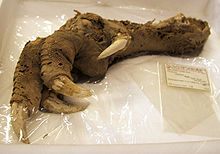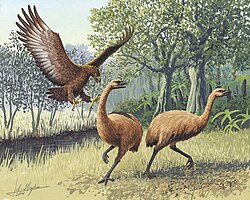恐鳥
 恐鳥
| ||||||||||||
| 物種分類 | ||||||||||||
| ||||||||||||
|
†Anomalopteryx (bush moa) |
恐鳥曾經係世界上最大隻嘅雀之一,同馬達加斯加嘅象鳥、非洲嘅鴕鳥一樣,都係屬於平胸鳥類(即係指自泛古陸開始遺留到而家嘅一類唔識飛嘅雀)。喺11種恐鳥中,就以巨型恐鳥(Dinornis robustus 同 Dinornis novaezelandiae)最大隻,身高甚至可達4米,重約 250 公斤,佢係紐西蘭嘅獨有品種。但喺白人殖民者(毛利人)到咗紐西蘭之後,就已經絕種。
特徵[編輯]

恐鳥係一種完全冇翼嘅雀,行動主要靠強而有力嘅大髀。羽毛呈褐色,同奇異鳥差唔多。有一條好長嘅頸,就好似雀鳥中嘅長頸鹿咁。不過一般情況下,佢哋都係將條頸呈水平橫向行走,只係間中寸條頸向上伸直望嘢。每種恐鳥無論喺體型上抑或咀嘅形狀上都各有不同,咁係為咗適應森林裏面唔同嘅生存模式。
天敵[編輯]

喺毛利人嚟到紐西蘭之前,哈斯特鷹相信係恐鳥最主要嘅捕獵者,呢種鷹會用佢哋好似虎爪咁大隻嘅利爪,用力按住恐鳥嘅背部,再開始進食。證據嚟自幾具恐鳥骨骼嘅骨盆上一啲窿,位置同大細都同哈斯特鷹嘅利爪符合。咁樣嘅傷口,腳爪必須穿恐鳥肌肉達5厘米咁深[2]。
但毛利人進駐紐西蘭之後,佢哋大量捕殺恐鳥以獲取營養豐富嘅鳥蛋同大髀肉,以及骨頭,皮同蛋殼作為生活上嘅必需品。
習性[編輯]
主要為獨居,或者以小家庭形式生活,有一定嘅地盤,而且有好強嘅保衛地盤意識。科學家相信,佢哋叫起嚟好似洪鐘咁,成個森林充斥住佢哋嘅「隆隆」聲。
所有恐鳥都係食齋嘅,主要食森林裏面嘅灌木同樹葉。紐西蘭好多本土嘅植物,為咗唔畀恐鳥食晒啲葉,都進化出好多由小枝構成嘅網絡結構。
因為紐西蘭以前並無陸上嘅捕獵者,連帶恐鳥嘅繁殖速率都減慢落嚟。有證據顯示,恐鳥一次只生一、兩隻蛋,而目前已發現少量嘅恐鳥巢,全部都係用岩石掩蔽嘅地窿。
絕種原因[編輯]
當毛利人進駐紐西蘭之後,佢哋開始發現呢種大型嘅雀除咗可帶嚟營養豐富嘅鳥蛋同大髀肉外,佢哋嘅骨頭,皮同蛋殼都分別成為生活上嘅主要用品,加上恐鳥性情溫馴,平易近人,先至成為大量捕獵嘅目標。而繁殖速率緩慢,亦加速佢哋嘅滅亡。
複製恐鳥[編輯]
喺紐西蘭嘅一個山窿遺跡裏面,俾人發現到有大量嘅恐鳥頭骨,估計係以前毛利人捉恐鳥嚟食時,所拋棄嘅頭骨部分,以及皮膚,羽毛等等,喺山窿遺跡度都保存得相當完好。而家牛津大學嘅科學家,正利用呢啲身體部分進行DNA研究,希望有朝一日,可以複製番呢種世界其中一種最大隻嘅雀[3]。
睇埋[編輯]
資料[編輯]
- Anderson, A. (1989). "On evidence for the survival of moa in European Fiordland" (PDF). New Zealand Journal of Ecology. 12 (Supplement): 39–44.
{{cite journal}}: Cite has empty unknown parameter:|month=(help) - Baker, Allan J. (2005). "Reconstructing the tempo and mode of evolution in an extinct clade of birds with ancient DNA: The giant moas of New Zealand". PNAS. 102 (23): 8257–8262. doi:10.1073/pnas.0409435102. PMID 15928096.
{{cite journal}}: Cite has empty unknown parameter:|month=(help); More than one of|author=、|last=specified (help) - Bunce, Michael (2003). "Extreme reversed sexual size dimorphism in the extinct New Zealand moa Dinornis". Nature. 425 (6954): 172–174. doi:10.1038/nature01871.
{{cite journal}}: Cite has empty unknown parameter:|month=(help); More than one of|author=、|last=specified (help) - Burrows, C. (1981). "The diet of moas based on gizzard contents samples from Pyramid Valley, North Canterbury, and Scaifes Lagoon, Lake Wanaka, Otago". Records of the Canterbury Museum. 9: 309–336.
{{cite journal}}: Cite has empty unknown parameter:|month=(help); More than one of|author=、|last=specified (help) - Dieffenbach, E. (1843). Travels in New Zealand.第II卷. London: John Murray. p. 195.
- Gill, BJ. (2007). "Eggshell characteristics of moa eggs (Aves: Dinornithiformes)". Journal of the Royal Society of New Zealand. 37: 139–150.
{{cite journal}}: Cite has empty unknown parameter:|month=(help) - Hartree, WH. (1999). "A preliminary report on the nesting habits of moas in the East Coast of the North Island". Notornis. 46: 457–460.
{{cite journal}}: Cite has empty unknown parameter:|month=(help) - Hill, H. (1913). "The Moa—Legendary, Historical and Geographical: Why and When the Moa disappeared". Transactions and Proceedings of the Royal Society of New Zealand. 46: 330.
{{cite journal}}: Cite has empty unknown parameter:|month=(help) - Holdaway, R. N. (2000). "Rapid Extinction of the Moas (Aves: Dinornithiformes): Model, Test, and Implications". Science. 287 (5461): 2250–2254. doi:10.1126/science.287.5461.2250. PMID 10731144.
{{cite journal}}: Cite has empty unknown parameter:|month=(help); More than one of|author=、|last=specified (help) - Horrocks, M. (2004). "Plant remains in coprolites: diet of a subalpine moa (Dinornithiformes) from southern New Zealand". Emu. 104: 149–156.
{{cite journal}}: Cite has empty unknown parameter:|month=(help); More than one of|author=、|last=specified (help) - Huynen, Leon J. (2003). "Nuclear DNA sequences detect species limits in ancient moa". Nature. 425 (6954): 175–178. doi:10.1038/nature01838.
{{cite journal}}: Cite has empty unknown parameter:|month=(help); More than one of|author=、|last=specified (help) - Millener, P. R. (1982). "And then there were twelve: the taxonomic status of Anomalopteryx oweni (Aves: Dinornithidae)". Notornis. 29: 165–170. doi:10.1371/journal.pbio.0030009.
{{cite journal}}: Cite has empty unknown parameter:|month=(help) - Polack, J. S. (1838). New Zealand: Being a Narrative of Travels and Adventures During a Residence in that Country Between the Years 1831 and 1837.第I卷. London: Richard Bentley. pp. 303, 307.
- Turvey, Samuel T. (2005). "Cortical growth marks reveal extended juvenile development in New Zealand moa". Nature. 435 (7044): 940–943. doi:10.1038/nature03635.
{{cite journal}}: Cite has empty unknown parameter:|month=(help); More than one of|author=、|last=specified (help) - Wood, JR. (2007). "Moa gizzard content analyses: further information on the diet of Dinornis robustus and Emeus crassus, and the first evidence for the diet of Pachyornis elephantopus (Aves: Dinornithiformes)". Records of the Canterbury Museum. 21: 27–39.
{{cite journal}}: Cite has empty unknown parameter:|month=(help) - Wood, JR. (2008). "Moa (Aves: Dinornithiformes) nesting material from rockshelters in the semi-arid interior of South Island, New Zealand". Journal of the Royal Society of New Zealand. 38: 115–129.
{{cite journal}}: Cite has empty unknown parameter:|month=(help) - Worthy, Trevor H. (2002). The Lost World of the Moa. Bloomington: Indiana University Press. ISBN 0253340349.
{{cite book}}: More than one of|author=、|last=specified (help)
出面網頁[編輯]
- TerraNature list of New Zealand's extinct birds
- Moa Pages
- TerraNature page on Moa
- Tree of Life classification and references
- Big Bird´s Last Stand
- Moa in Te Ara - the Encyclopedia of New Zealand

